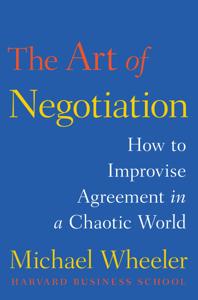
Want to learn the ideas in The Art of Negotiation better than ever? Read the world’s #1 book summary of The Art of Negotiation by Michael A. Wheeler here.
Read a brief 1-Page Summary or watch video summaries curated by our expert team. Note: this book guide is not affiliated with or endorsed by the publisher or author, and we always encourage you to purchase and read the full book.
Video Summaries of The Art of Negotiation
We’ve scoured the Internet for the very best videos on The Art of Negotiation, from high-quality videos summaries to interviews or commentary by Michael A. Wheeler.
1-Page Summary of The Art of Negotiation
Overview
Sometimes, people get out of hand during conversations and it’s hard to keep things under control. This book will help you figure out why this happens and how to prevent it from happening in the future.
In life, we all have to negotiate. Whether you’re negotiating for a raise or buying a new home, it’s an important skill that can help you get what you want.
Thus, the world could use more negotiation skills. The author will teach you what to do with these key points by learning from jazz musicians and flexible people.
Big Idea #1: The best way to negotiate is to come up with a plan beforehand, but be flexible enough in the actual process of negotiation.
Imagine you’re in a salary negotiation and you know exactly what you want. You deserve $120,000 annually, not less! However, if they say no to your request, will you be able to maintain control of the negotiation? Probably not.
It’s good that you knew what you wanted. But, without a map for your negotiations, it was difficult to take advantage of the opportunities.
When you’re trying to negotiate something, start by identifying your ultimate goal and several minimum goals. Then, if you don’t get the ultimate goal that you want, at least you have a good alternative.
Baselines are important in negotiations, because your partner has their own goals. For example, if you’re negotiating for a higher salary and the other party rejects that offer, then you can use baselines to negotiate with them. These baselines might be things like “a yearly salary of $100,000” or “$90,000 plus stock options.”
Maps are useful for knowing where you’re going, but they can also give you confidence.
It was the same principle that saved a military patrol unit from certain death after becoming lost in the Swiss Alps. The team had to find a way out, and they did by using their pocket maps, which led them to safety despite not being maps of the Alps.
However, the assumption that they knew where they were going gave them confidence to survive.
Big Idea #2: Before you enter a negotiation, make sure to consider various scenarios and have a backup plan.
You wouldn’t make a recipe without preparing the ingredients first, and you shouldn’t negotiate without preparing yourself first.
Before you negotiate with someone, ask yourself when is the best time to do that. It’s important to choose the right time for negotiations and don’t try to make deals at a less than optimal time. For example, don’t sell your ski equipment in spring – it may not be very effective because people are not interested in skiing at this time of year.
If you’re trying to negotiate a deal, ask yourself if the other party is likely to agree. If they are unlikely to agree, it’s probably not worth pursuing this deal.
For example, you won’t get very far if you try to negotiate down the price of vegetables at a supermarket. However, you might be able to haggle with vendors at your local farmers’ market. If you’re in the mood to haggle and want to try it out, then that’s where you should concentrate your efforts.
Although you should prepare thoroughly, things won’t always go as planned. Therefore, it’s important to come up with a Plan B in case your original plan fails.
In negotiations, it is often a good tactic to use an example of a small business owner who wanted to expand his business by buying another company. Unfortunately for him, the highest offer he could make was still much lower than what the other party expected. Instead of purchasing the company and making a smaller profit, he sold his own business and made more money in that deal. This shows how sometimes when you have no chance of succeeding with your plan, you can consider options that you hadn’t thought about before.





